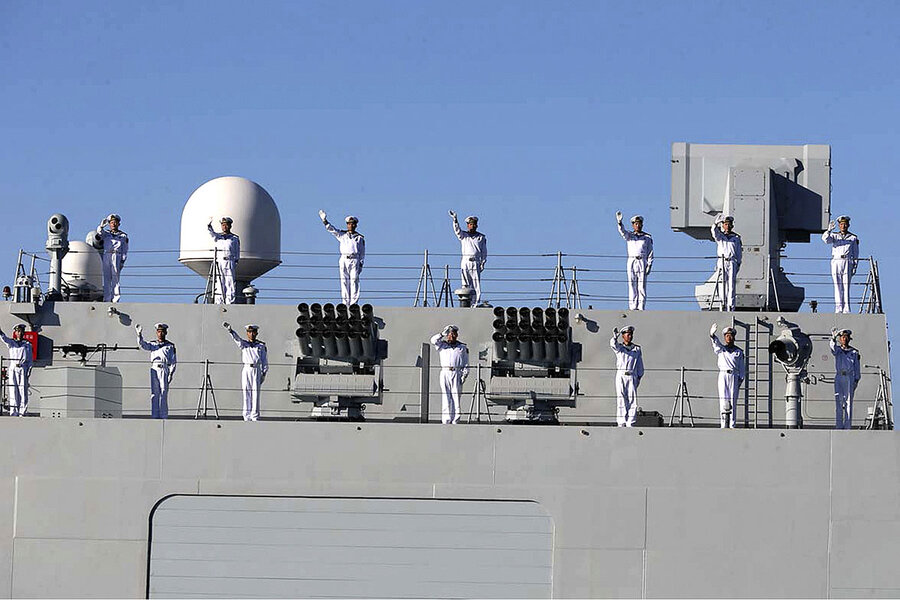How Iran-US tensions could benefit a new Mideast player: China
Loading...
| London
The aftermath of the U.S. killing of Iran’s Maj. Gen. Qassem Soleimani has focused attention on familiar Mideast players like Saudi Arabia, Israel, Lebanon, and Russia.
But a less overtly involved power may be most worth watching. When it comes to China’s long-range goals of equaling or surpassing the U.S. in superpower influence, events in the Middle East may be moving in its favor.
Why We Wrote This
Those with a lot to gain from a crisis are not always immediately obvious. But the economic and diplomatic reverberations from the U.S.-Iran clash could play to China's long-term interests.
Saudi Arabia, America’s closest Gulf ally, has become uneasy over President Donald Trump’s Iran policy. By the time of the Soleimani killing, Gulf Arabs were working to open diplomatic channels with Iran. They’ve also been building relations with China. China, meanwhile, has been increasing purchases of Saudi crude oil, and has established its first overseas naval facility in Djibouti.
Ironically, one main strategic gain for the Chinese could come from Mr. Trump’s decision to pull out of the nuclear deal, and the U.S.-Iranian confrontation that has followed.
Two years ago, a new U.S. National Defense Strategy identified “strategic competition” with China as a top priority. Mr. Trump’s insistence that he’d like to get American troops out of the Middle East may partially reflect that strategy. But regional tensions have forced the U.S. to stall such moves.
The main cast in the intensifying conflict in the Middle East is complex enough: the United States and Iran; Saudi Arabia and the other Sunni monarchies across the Gulf; Israel and its Iran-influenced neighbor, Lebanon; and, with increasing clout after its military intervention in Syria, Russia.
But a less overtly involved outside power may be most worth watching: China, with its own growing Middle East economic, diplomatic, and strategic interests. The Chinese are no more immune than anyone else from the immediate effects of the escalation between the U.S. and Iran. Yet they could emerge as principal longer-term beneficiaries.
Even before the U.S. attack that killed Iranian military commander Qassem Soleimani earlier this month, China’s economic strategy in the region had taken a major hit from President Donald Trump’s tightening economic sanctions on the Iranians.
Why We Wrote This
Those with a lot to gain from a crisis are not always immediately obvious. But the economic and diplomatic reverberations from the U.S.-Iran clash could play to China's long-term interests.
China had been relying on Iran as a major source of oil imports. Iran was also meant to be an important cog in Chinese leader Xi Jinping’s trillion-dollar Belt and Road Initiative: a series of economic, investment, and infrastructure deals with countries across Asia, through the Middle East, and into Europe and Africa.
Yet when it comes to China’s longer-term diplomatic and strategic goal – to equal, and ultimately surpass, the U.S. in superpower influence – events in the Middle East may be moving in its favor.
Uneasy U.S. allies
The Americans’ main Gulf ally, Saudi Arabia, has become increasingly uneasy over Mr. Trump’s Iran policy. The Saudis have long viewed Iran’s expanding political and military influence as the region’s primary security threat, and they initially welcomed the Trump administration’s hard-line approach.
But Mr. Trump’s lack of significant military response to a series of allegedly Iran-instigated attacks in the Gulf – especially a drone strike on Saudi oil facilities last September – left the Saudis and other Gulf Arab states fearful of a wider conflict with Iran in which they’d be left on their own.
One effect was that, by the time of the Soleimani killing, the Gulf Arabs had begun efforts to open diplomatic channels with Iran.
But they’ve also been building their relations with China. While similar outreach to Russia has garnered a lot of media attention, the Chinese have potentially a far greater attraction.
Unlike the Russians, they’re not involved in a shooting war, on the side of an Iranian-backed regime in Syria. The Chinese have begun to dip their toes in militarily, establishing their first overseas naval facility in Djibouti, at the foot of the Red Sea. But China is the equivalent of the new kid in the neighborhood, not only open to, but eager for, relations with all sides.
The Chinese are also a lot wealthier than the Russians. And, unlike the now energy-sufficient U.S., they have a need for oil. China has become the world’s largest oil purchaser. Its imports account for around three-quarters of domestic consumption. With U.S. sanctions greatly reducing Chinese imports from Iran, in fact, Beijing has partly been making up the shortfall by increasing its purchases of Saudi crude.
China: Transactional diplomacy, not taking sides
China’s Middle East approach, at least for now, is purely transactional. The Chinese are ready to provide money, whether for oil purchases or investment and infrastructure projects. In return, they stand to get needed energy supplies, as well as a greater presence in the region. As for the politics, they’re not taking sides, limiting themselves to supporting diplomatic efforts aimed at preventing conflict – notably the bid, however unlikely, to rescue the remnants of the 2015 Iran nuclear deal of which it was a co-signatory.
Ironically, one main strategic gain for the Chinese could come from Mr. Trump’s decision to pull out of the nuclear deal, and the U.S.-Iranian confrontation that has followed.
Two years ago, a new U.S. National Defense Strategy identified “strategic competition” with China as a top priority. Mr. Trump’s insistence that he’d like to get American troops out of the Middle East may in part be a reflection of that new strategy.
But regional tensions have forced the administration to stall moves to draw down its military presence. It has brought back an aircraft carrier and other vessels that had been deployed to the Pacific. Since the Soleimani attack, a further 3,000 American troops have been sent to the area.
How long they’ll stay is impossible to say. So is pretty much anything about the future of the U.S.-Iran showdown, especially with Iran threatening further retaliation, and resurgent street protests against the regime inside Iran.
President Trump does still seem to want to reduce the U.S. military presence, freeing him to focus on getting the necessary trade and economic concessions from China to end their tariff war. His hope appears to be for the European countries in NATO to take over the bulk of the Mideast security burden.
The problem is that, like the Saudis, some NATO partners have begun to question the strength of Washington’s own commitment as an ally. That concern was starkly on view this past weekend, with unprecedented remarks from the defense secretary of America’s closest European partner, the United Kingdom.
Referring to Britain’s own strategic policy review, the first in a decade, Ben Wallace said he was being “kept up at night” by concern over a possible American withdrawal from its international leadership role. “The assumptions of 2010 that we were always going to be part of a U.S. coalition,” he said, “is really just not where we are going to be.”








